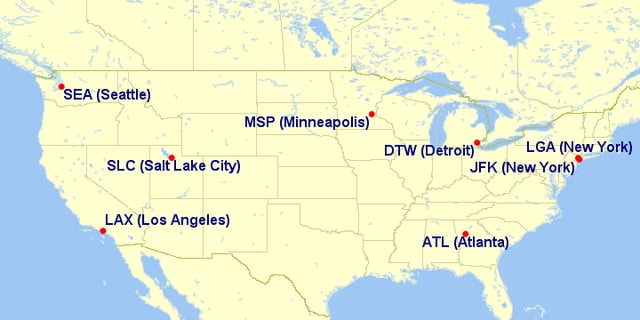Delta Air Lines

Delta Air Lines

| Founded | May 30, 1924(asHuff Daland Dusters)Macon, Georgia, U.S.[1] |
|---|---|
| Commenced operations | June 17, 1929[2] |
| AOC # | DALA026A[3] |
| Hubs | |
| Focus cities | |
| Frequent-flyer program | SkyMiles |
| Alliance | |
| Subsidiaries | |
| Fleet size | 911(As of September 2019)[5] |
| Destinations | 325(As of 31 March 2019)[6] |
| Company slogan | "Keep Climbing"[7] |
| Traded as | NYSE: DAL[190]Dow Jones Transportation AveragecomponentS&P 500 Indexcomponent |
| ISIN | |
| Headquarters | Atlanta, Georgia, U.S. |
| Key people | C.E.Woolman (Founder)Ed Bastian(CEO)Glen Hauenstein (President)Joanne Smith (E.V.P. & Chief People Officer) |
| Revenue | |
| Operating income | |
| Net income | |
| Total assets | |
| Employees | 86,564 (2018) |
| Website | |
| Notes | |
Delta Air Lines, Inc., typically referred to as Delta, is one of the major airlines of the United States and a legacy carrier. It is headquartered in Atlanta, Georgia.[3] The airline, along with its subsidiaries and regional affiliates, including Delta Connection, operates over 5,400 flights daily and serves 325 destinations in 52 countries on 6 continents.[10] Delta is a founding member of the SkyTeam airline alliance.[10]
Delta has nine hubs, with Atlanta being its largest in terms of total passengers and number of departures.[10] It is ranked second among the world's largest airlines by number of scheduled passengers carried, revenue passenger-kilometers flown, and fleet size. It is ranked 69th on the Fortune 500.[11]
| Founded | May 30, 1924(asHuff Daland Dusters)Macon, Georgia, U.S.[1] |
|---|---|
| Commenced operations | June 17, 1929[2] |
| AOC # | DALA026A[3] |
| Hubs | |
| Focus cities | |
| Frequent-flyer program | SkyMiles |
| Alliance | |
| Subsidiaries | |
| Fleet size | 911(As of September 2019)[5] |
| Destinations | 325(As of 31 March 2019)[6] |
| Company slogan | "Keep Climbing"[7] |
| Traded as | NYSE: DAL[190]Dow Jones Transportation AveragecomponentS&P 500 Indexcomponent |
| ISIN | |
| Headquarters | Atlanta, Georgia, U.S. |
| Key people | C.E.Woolman (Founder)Ed Bastian(CEO)Glen Hauenstein (President)Joanne Smith (E.V.P. & Chief People Officer) |
| Revenue | |
| Operating income | |
| Net income | |
| Total assets | |
| Employees | 86,564 (2018) |
| Website | |
| Notes | |
History
Delta Air Lines began as a crop dusting operation called Huff Daland Dusters, Incorporated. The company was founded on May 30, 1924, in Macon, Georgia, and moved to Monroe, Louisiana, in 1925. They flew a Huff-Daland Duster, the first true crop duster, designed to combat the boll weevil infestation of cotton crops. Collett E. Woolman, one of the original directors, purchased the company on September 13, 1928, and renamed it Delta Air Service. Service began on June 17, 1929, with the inaugural flight between Dallas, Texas and Jackson, Mississippi.[12] The company has four founders: the principal founder Collett E. Woolman, C. H. McHenery, Travis Oliver, and Malcolm S. Biedenharn.[13][14][1]
Delta moved its headquarters from Monroe, Louisiana to its current location in Atlanta in 1941. In 1946, the company commenced regularly scheduled freight transport. In 1949, the company launched the first discounted fares between Chicago and Miami. In 1953, the company launched its first international routes after the acquisition of Chicago and Southern Air Lines. In 1959, it was the first airline to use Douglas DC-8 planes. In 1960, it was the first airline to use Convair 880 jets. In 1964, it launched the Deltamatic reservation systems using computers in the IBM 7070 series. In 1965, it was the first airline to use McDonnell Douglas DC-9 jets. By 1970, it had an all-jet fleet. In 1972, it acquired Northeast Airlines. In 1981, it launched a frequent-flyer program. In 1987, it acquired Western Airlines. In 1990, it was the first airline in the United States to use McDonnell Douglas MD-11 jets. In 1991, it acquired the Pan Am Shuttle, rebranded as the Delta Shuttle.[1]
In 1997, Delta was the first airline to board more than 100 million passengers in a calendar year.
Also this year Delta began an expansion of their international routes into Latin America.[15]
In 2003, the company launched Song, a low-cost carrier.[1]
Bankruptcy
On September 14, 2005, the company filed bankruptcy, citing rising fuel costs.[16][17][18] It emerged from bankruptcy in April 2007 after fending off a hostile takeover from US Airways and its shares were re-listed on the New York Stock Exchange.[19][20][21]
Acquisition of Northwest Airlines
The acquisition of Northwest Airlines was announced April 14, 2008. It was approved and consummated on October 29, 2008. Northwest continued to operate as a wholly owned subsidiary of Delta until December 31, 2009, when the Northwest Airlines operating certificate was merged into that of Delta.[22] Delta completed integration with Northwest on January 31, 2010, when their computer reservations system and websites were combined, and the Northwest Airlines brand was officially retired.[23]
Destinations and hubs
Destinations
Delta and its worldwide alliance partners operate more than 15,000 flights per day.[10]
Delta is the only U.S. carrier that flies to Accra, Copenhagen, Dakar, Düsseldorf, Johannesburg, Lagos, Nice, Ponta Delgada (seasonal), and Stuttgart. In May 2019, the company announced non-stop flight service between New York's JFK and Mumbai, to begin on December 22, 2019.[24]
Hubs
Atlanta – Delta's hub for the Southeast and its main gateway to Latin America and the Caribbean. In addition to its corporate headquarters, Delta operates its primary hub in Atlanta as well as Delta TechOps, Delta's primary maintenance base.[26]
Boston[27] – Delta's secondary transatlantic hub. It had previously been a hub from the second half of the 20th century through the early 2000s. The present Terminal A was built for Delta's sole use, but following the 2005 bankruptcy, Delta scaled back operations and leased 11 gates in the terminal. Delta subsequently regained all the Terminal A gates and began building up operations in the mid 2010s until declaring it a hub in 2019.
Detroit – Inherited through the merger with Northwest, Detroit serves as one of Delta's two Midwest hubs and is Delta's second largest overall. It is the primary Asian gateway for the Eastern United States and it also provides service to many destinations in the Americas and Europe.
Los Angeles – Delta's secondary West Coast hub. Delta inherited its LAX hub from Western Airlines, but dismantled it in the mid-1990s, opting to relocate most of those aircraft to the U.S. East Coast. Since then, it has re-opened the hub, offering service to select cities in Latin America, Asia, Australia and Europe, as well as major domestic cities and West Coast regional destinations.
Minneapolis–Saint Paul – Inherited through the merger with Northwest, Minneapolis–Saint Paul serves as one of Delta's two Midwest hubs and is Delta's third largest overall. It is the primary Canadian gateway for the airline while including many American metropolitan areas, a number of regional destinations in the upper Midwest as well as some destinations in Europe and Asia.
New York–JFK – Delta's primary transatlantic hub. Inherited from its partnership with Pan Am after Pan Am's collapse in 1991. Also offers service on many transcontinental "prestige routes" to west coast destinations Los Angeles, San Francisco and Seattle.
New York–LaGuardia – Delta's second New York hub. An important domestic hub created as a result of a slot swap with now-defunct US Airways. Delta service at LaGuardia covers numerous east coast US cities, and a number of regional destinations in the US and Canada.
Salt Lake City – Delta inherited Salt Lake City during the Western Airlines merger and it is currently the fourth largest hub for the airline. Service covers most major US destinations as well as a number of regional destinations in the US, with an emphasis on the Rocky Mountain region, as well as Canada, Mexico, and select cities in Europe and Hawaii.
Seattle/Tacoma – Delta's primary West Coast hub. Delta announced Seattle's hub status in 2014. The hub serves as an international gateway to Asia for the Western United States. Service also includes many major US destinations as well as regional destinations in the Pacific Northwest. Delta started aggressively building its presence in Seattle in 2011, sparking tensions with Seattle-based Alaska Airlines.[28]
Alliance and codeshare agreements
Aeroflot[32]
Aerolíneas Argentinas[33]
Aeroméxico[34]
Air Europa
Alitalia
China Airlines
China Eastern Airlines
China Southern Airlines
Czech Airlines
Garuda Indonesia
Gol Transportes Aéreos[35]
Hawaiian Airlines
Kenya Airways[36]
KLM
Korean Air[37]
Seaborne Airlines[38]
Transavia[39]
Vietnam Airlines[40]
Virgin Atlantic[41]
Virgin Australia
WestJet[42]
Joint ventures
In addition to the above codeshares, Delta has also entered into joint ventures with the following airlines.
Air France–KLM/Alitalia – Delta, as successor to Northwest Airlines, has a transatlantic joint venture with Air France-KLM and Alitalia. The program coordinates transatlantic operations, including ticket pricing, schedules, capacity, and revenue. On January 27, 2012, the European Commission launched an investigation into possible violations of competition law.[43]
Virgin Atlantic – On December 11, 2012, Delta announced that it would acquire the 49% stake in Virgin Atlantic held by Singapore Airlines for $360 million. The two airlines operate a total of 31 roundtrip flights between the UK and North America, including nine daily roundtrip flights between London and New York City airports (John F. Kennedy International Airport and Newark), with costs shared between the two airlines.[44] The two airlines' application for antitrust immunity was granted by the United States Department of Transportation on September 23, 2013.[45]
Aeromexico – Delta owns 49% of Mexican flag carrier Aeroméxico. In 2015, Delta and Aeromexico applied for an immunized joint venture. After two years, the joint venture was approved with two conditions: both airlines had to surrender four slot pairs at John F. Kennedy International Airport and 24 at Mexico City International Airport to competitors (both airports have slot restrictions). The joint venture began in May 2017, at which time Aeromexico moved to Delta gates at both Kennedy and Los Angeles International Airport.[46]
Korean Air – In 2016, Delta and Korean Air began to lay the groundwork for a trans-Pacific joint venture to compete against those between American Airlines and Japan Airlines, and United Airlines and All Nippon Airways. Unlike other planned joint ventures, the Delta-Korean Air joint venture was quick to receive approval by both the US Department of Transportation and the Korean Ministry of Land, Infrastructure and Transport.[47] They aim to increase belly cargo cooperation and offer benefits to its customers across one of the most comprehensive route networks in the trans-Pacific market. This joint venture gives Delta and Korean Air's shared customers seamless access to more than 290 destinations in the Americas and more than 80 in Asia. This joint venture officially launched in May 2018, exactly one year after the joint venture with Aeromexico began.[48]
WestJet – Delta Air Lines and Canadian airline WestJet operate a codeshare agreement on select routes in North America. On July 19, 2018, WestJet and Delta Air Lines signed a 10-year agreement. The airlines' also aligned their frequent flier programs and are co-located at key hub airports.
Virgin Australia – In 2017, Delta announced a joint venture with Virgin Australia, strengthening its trans-pacific network and allowing the carrier to add direct flights between Australia and the United States.
LATAM - In September 2019, Delta announced its plans to buy 20% of LATAM for $1.9 billion which will expand Delta's access to Latin America and remove LATAM from Oneworld.[49]
Fleet
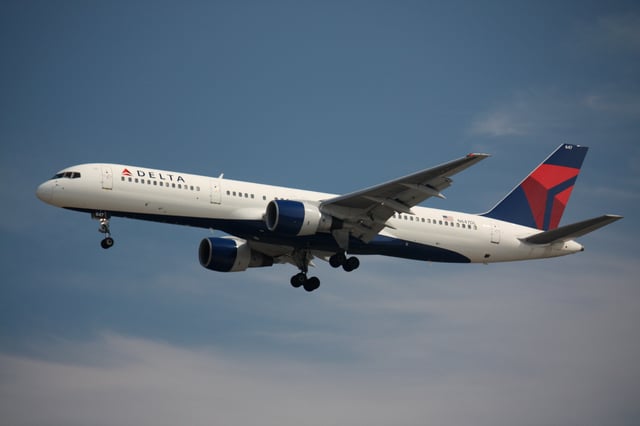
Delta Air Lines has the largest Boeing 757 fleet of any airline

The Airbus A330-900 is the newest aircraft in Delta's fleet, with entry into service in July 2019.
As of September 2019, Delta operates a fleet of 911 aircraft[5] manufactured by Airbus, Boeing, and McDonnell Douglas.[10] Delta operates the largest Boeing 717, Boeing 757, Boeing 767, McDonnell Douglas MD-88, and McDonnell Douglas MD-90 fleets in the world, and the largest Airbus A330 fleet of any US airline. Prior to its 2008 merger with Northwest Airlines, Delta's fleet was made up of solely Boeing and McDonnell Douglas aircraft. Airbus aircraft from Northwest joined the fleet after the merger, and more have since been added.
Delta often seeks to acquire and utilize older aircraft, especially narrow-bodies, and it has created an extensive MRO (maintenance, repair, and overhaul) organization, called TechOps, to support them.
The oldest aircraft in the fleet are the McDonnell Douglas MD-88s, with an average age of over 25 years.[50] However, in early 2011, Delta began talks with Airbus, Boeing and Bombardier Aerospace to discuss replacing the McDonnell Douglas DC-9s, MD-88s, and older A320 and 757-200 aircraft.[51] On August 22, 2011, Delta placed an order for 100 Boeing 737-900ER aircraft[52] and deferred an order of 100 small narrow-body jets until 2012.[53]
As part of its strategy to utilize less expensive used airplanes, Delta agreed in 2012 to lease 88 Boeing 717s acquired by Southwest Airlines as part of its acquisition of AirTran Airways.[54] They replaced some McDonnell Douglas DC-9s and some 50-seat regional aircraft such as the CRJ-200. The first revenue flight was on October 25, 2013,[55] Delta officially retired its last McDonnell Douglas DC-9 on January 6, 2014; it was used on an as-needed basis until January 22, 2014, when the last one was removed from service.[56] Delta was the final US carrier operating the McDonnell Douglas DC-9.[57] As a continuation of the narrowbody fleet refresh and expansion, Delta ordered 75, and later expanded that order to 95, Airbus A220 (formerly the Bombardier CSeries) aircraft, and became the first American carrier to order the plane.[58][59][60]
The airline has not been as keen to acquire or operate aging wide-body aircraft.
In August 2014, Delta announced it would begin to retire its aging Boeing 747-400 fleet, which Delta acquired as part of the Northwest merger.[61] During a 2014 earnings call, CEO Richard Anderson announced that they would be retired by the end of 2017.[62] On November 20, 2014, the airline announced an order for 25 Airbus A350 XWB and 25 Airbus A330neo aircraft to replace the 747 fleet as it was retired, as well as some aging 767s. A350 deliveries began in the second quarter of 2017, while the first A330-900neo flew in 2019.[63] Delta retired the 747 on January 3, 2018, with its final revenue flight from Seoul-Incheon to Detroit (DL158) occurring on December 19, 2017, becoming the last major U.S. airline to fly the 747.[64][65]
On December 14, 2017, Delta ordered 100 Airbus A321neos, with 100 further options for $25.4 billion at list prices, to be delivered from 2020; equipped with Pratt & Whitney PW1100Gs and will be configured with maximum of 197 passengers, they will replace the airline's aging Airbus A319s, Airbus A320s, Boeing 757-200s, MD-88s and MD-90s.[66]
Cabin
Delta underwent a cabin branding upgrade in 2015.[67] The airline now offers or plans to offer 6 different cabin service options: Delta One, Delta Premium Select, First Class, Comfort+, Main Cabin, and Basic Economy.
Availability and exact details vary by route and aircraft type.
Delta One
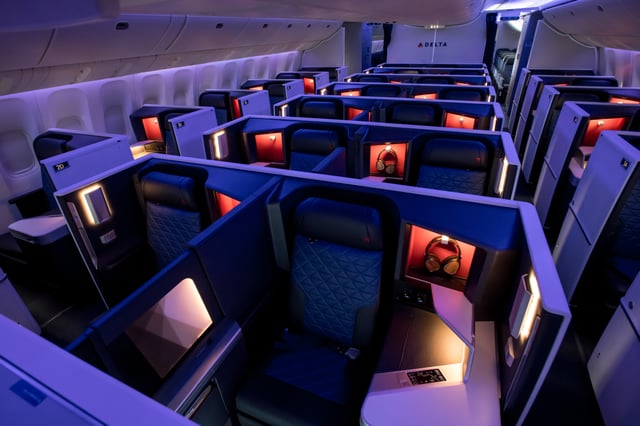
Delta One Suite on a Boeing 777
Delta One is the airline's premier business class product, available on long haul international flights, as well as transcontinental service from New York-JFK to Los Angeles and San Francisco.[67]
Delta One features lie-flat seating on all aircraft types, and direct aisle access from every seat on all types except the Boeing 757-200 (in which only a special sub-fleet of approximately 20 aircraft feature lie-flats).[68] The Boeing 767-300ER and Boeing 767-400ER seats, designed by James Thompson, feature a space-saving design whereby the seats are staggered such that when in the fully flat position, the foot of each bed extends under the armrests of the seat in front of it. Delta One cabins on the Boeing 777-200ER/LR fleet are configured in a herringbone layout, while Airbus A330 cabins (featuring the Cirrus flat-bed sleeper suite by Zodiac Seats U.S.) are configured in a reverse herringbone pattern.[69]
All seats are also equipped with a personal, on demand In-Flight-Entertainment (IFE) system, universal power-ports, a movable reading light, and a folding work table.
Passengers also receive complimentary chef-curated meals, refreshments, alcoholic beverages, a Tumi Inc. amenity kit, premium bedding, and pre-flight Sky Club access.[70]
In August 2016, Delta announced the introduction of Delta One Suites on select widebody fleets.
The suites will feature a door to the aisle for enhanced privacy, as well as improved storage space, a larger IFE screen, and updated design.
The suites will roll out on the Airbus A350 fleet, first delivered in July 2017, followed by installation within the Boeing 777 fleet.[71][72]
Premium Select
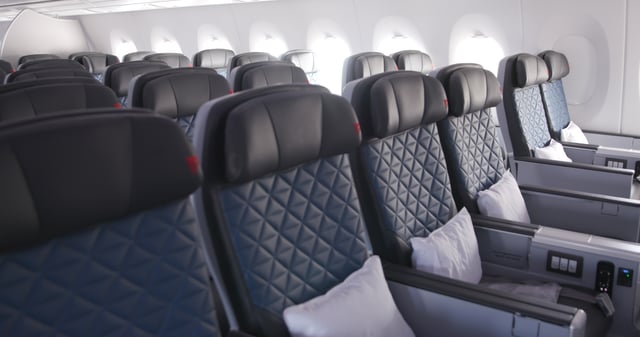
Delta Premium Select on an Airbus A350-900
In April 2016, Delta CEO Ed Bastian announced that a new Premium Economy cabin will be added.
Since renamed to Premium Select, this cabin will feature extra legroom; adjustable leg rests; extra seat pitch, width, and recline; and a new premium service.
Delta introduced it on its new Airbus A350, first delivered in fall 2017, and will be followed by the Boeing 777.[73] In October 2018, Delta announced that they would be selling First Class seats on domesticly configured Boeing 757 aircraft flying transatlantic routes as Premium Select.[74]
First Class

First class on a Delta A220-100.
First Class is offered on mainline domestic flights (except those featuring Delta One service), select short- and medium-haul international flights, and Delta Connection aircraft with more than 50 seats.
Seats range from 18.5 to 20.75 inches (47.0 to 52.7 cm) wide and have between 37 and 40 inches (94 and 102 cm) of pitch.
Passengers in this class receive a wider variety of free snacks compared to Main Cabin, as well as free drinks and alcohol, and full meal service on flights 900 miles (1,400 km) and longer.
Certain aircraft also feature power-ports at each seat and free entertainment products from Delta Studio.
First Class passengers are also eligible for priority boarding.[70]
Delta Comfort+
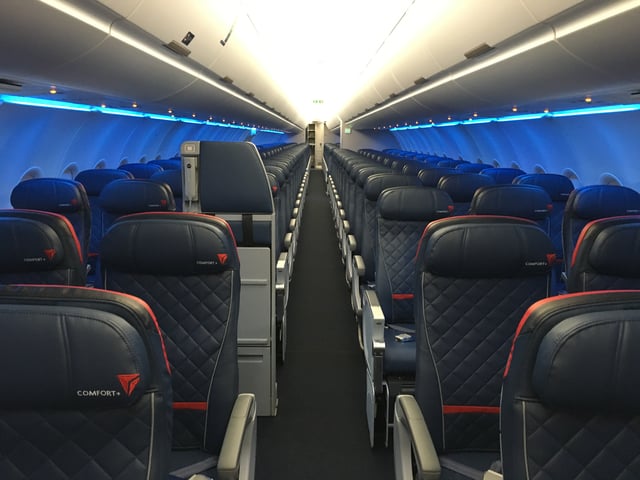
Delta Comfort+ on an Airbus A321
Delta Comfort+ seats are installed on all aircraft excluding Delta's new A350s and feature 34–36 inches (860–910 mm) of pitch; on all Delta One configured aircraft, 35–36 inches (890–910 mm) of pitch and 50 percent more recline over standard Main Cabin seats.[75] Additional amenities include: Sky Priority Boarding, dedicated overhead space, complimentary beer, wine, and spirits on flights 250 miles (400 km) or more, and complimentary premium snacks on flights 900 miles (1,400 km) or more.
Complimentary premium entertainment is available via Delta Studio, with free headsets available on most flights.[70] On transcontinental flights between JFK-LAX/SFO, Delta Comfort+ passengers also get Luvo snack wraps. Medallion members can upgrade from Main Cabin to Comfort+ for free, while other customers can upgrade for a fee or with SkyMiles.[76]
Main Cabin
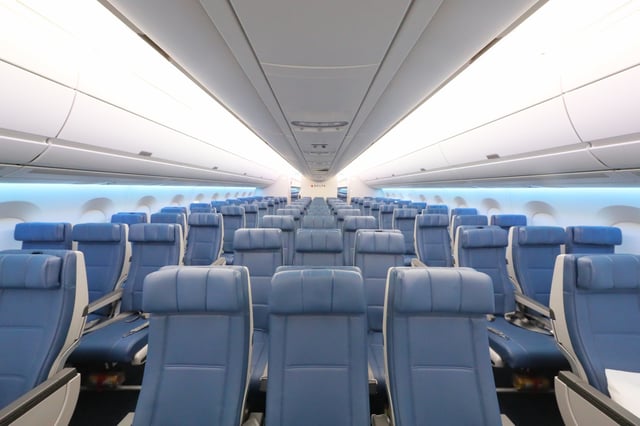
Main Cabin on an Airbus A350-900
Main Cabin is available on all aircraft with seats ranging from 17 to 18 inches (43 to 46 cm) wide and 30 to 33 inches (76 to 84 cm) of pitch.
The main cabin on Boeing 737, 777, and selected Boeing 757-200, 767-300, and McDonnell Douglas MD-90 aircraft have an articulating seat bottom where the seat bottom moves forward in addition to the seat back tilting backwards when reclining.[77]
Main Cabin passengers receive complimentary snacks and non-alcoholic drinks on all flights 250 miles (400 km) or longer.
Alcoholic beverages are also available for purchase.
Complimentary meals and alcoholic drinks are provided on long-haul international flights as well as selected transcontinental domestic flights, such as between New York–JFK and Seattle, San Francisco, Los Angeles, and San Diego.[78][79] As part of Delta's Flight Fuel buy on board program, meals are available for purchase on other North American flights 900 miles (1,400 km) or longer.[78]
Delta operated a different buy on board program between 2003 and 2005.[80][81] The previous program had items from differing providers, depending on the origin and destination of the flight.[82][83] Prices ranged up to $10 ($13.26 when adjusted for inflation). The airline started the service on a few selected flights in July 2003, and the meal service was initially offered on 400 flights.[84] Delta ended this buy on board program in 2005; instead, Delta began offering snacks at no extra charge on flights over 90 minutes to most U.S. domestic flights and some flights to the Caribbean and Latin America. Beginning in mid-March 2005 the airline planned to stop providing pillows on flights within the 48 contiguous U.S. states, Bermuda, Canada, the Caribbean, and Central America. In addition, the airline increased the price of alcoholic beverages on Delta mainline flights from $4 ($5.13 when adjusted for inflation) to $5 ($6.41 when adjusted for inflation); the increase in alcohol prices did not occur on Song flights.[84]
Basic Economy
Basic Economy is a basic version of Main Cabin, offering the same services with fewer flexibility options for a lower price.[67] Examples of fewer flexibility options include no ticket changes, no paid or complimentary upgrades regardless of frequent-flier status, and only having a seat assigned at check-in.[85]
On-board amenities
Wi-Fi
On August 5, 2008, Delta announced it would be installing the Aircell mobile broadband network, Gogo Inflight Internet, which enables customers traveling with Wi-Fi enabled devices, such as laptops, smartphones, and tablets, to access the Internet for a fee. Gogo was initially offered on Delta's fleet of McDonnell Douglas MD-88 and MD-90 aircraft but has expanded to the remaining domestic fleet, as well as Delta Connection aircraft with a first class cabin.[86]
Delta has the largest fleet of Wi-Fi-equipped aircraft in the world.[87] The airline introduced its first in-flight Wi-Fi on international routes to Tokyo from Los Angeles and Atlanta in March 2014, and stated its intent to offer the service on all transoceanic flight routes by the end of 2015.[88] Even though Delta had announced the retirement of its 747 fleet, all Delta 747s were wifi-equipped before their withdrawal. Delta is currently installing wifi on the Boeing 777 fleet.[89]
In-flight entertainment
History
In the 1960s, audio programming was introduced where passengers wore headphones consisting of hollow tubes piping in music.
These were installed in some Delta aircraft.
Some early wide-bodied aircraft, including the Lockheed L-1011, Boeing 767-200, and 767-300 fleet, had movies projected on to the cabin bulkhead. Also during the late 1980s and early 1990s, CRT monitors over the aisles were added to the 757 fleet, making them the first narrowbody aircraft to feature video entertainment. The MD-90 introduced Delta's first IFE system with LCD monitors in 1995, and the 777 introduced Delta's first in-seat video system in 1999, initially using the Rockwell Collins Total Entertainment System. Delta's first all-digital IFE system with AVOD (Panasonic eFX) was first introduced in 2003 on Delta's former low-cost subsidiary, Song. The Rockwell Collins IFE system on the 777s was replaced by the Panasonic eFX system in 2007, followed by the Panasonic eX2 in 2011. The Panasonic eFX and eX2 systems are trademarked by Delta as "Delta on Demand".[92]
On July 27, 2010, Delta announced that it would be the launch customer of the new eX2 AVOD system with the Eco 9i Integrated Smart Monitor, a new ultra-lightweight IFE system by Panasonic Avionics Corporation and Zodiac Seats U.S..[95] The systems have been installed on the entire 747-400 fleet as of October 2012, and are currently being installed on the 767-300ER fleet (except for the six aircraft previously retrofitted with the eFX system in 2010).[96] A different version of the Integrated Smart Monitor developed by Panasonic Avionics Corporation and BE Aerospace was installed on the Airbus A330 fleet. These seats were also installed on all Boeing 757-300, Boeing 737-900ER, Airbus A321 and select Boeing 757-200 domestic aircraft, and replaced the existing seats and monitors on the international Boeing 757-200 fleet. The previous seats on the international 757-200 fleet have been placed on select domestic 757-200 aircraft, mainly ones flying between Hawaii and the U.S. mainland.
In 2012, Delta began replacing the overhead CRT monitors on the pre-merger Delta 757-200 fleet with new LCD monitors.[97] This was completed in late 2012.
The 767-400ER fleet initially featured LCDs over the aisles, but were replaced in 2009 by the Panasonic eFX AVOD system when the last of the 767-400ERs were converted from domestic to international use.
CRT projectors were originally featured in economy class on Boeing 767–300s, with the international 767-300ERs also featuring ceiling-mounted CRT displays over the aisles, which have since replaced by LCD monitors, and are now in the process of being converted to the eFX2 AVOD system.
When Delta's ex-TWA ETOPS 757s were first delivered, they featured a system made by Sony Transcom (a former subsidiary of Sony now sold to Rockwell Collins) system that was factory installed for TWA. The system featured overhead drop-down LCD monitors similar to Delta's non-Transcon 737-800s and 757-300s. Delta replaced the Sony Transcom system with the Panasonic eFX system featuring in-seat video and AVOD at the same time as the new BusinessElite seats and slimline economy class seats were installed.[98]
Current fleet
Audio and video are available on all aircraft except for the McDonnell Douglas MD-88, Boeing 717, MD-90, and Delta Connection aircraft. Boeing 777-200ER, 777-200LR, along with 767-300 and A330 aircraft that have completed cabin modifications, feature the Panasonic eX2 system. Compared to the older eFX system, this offers greater storage capacity, as well as lighter and larger personal video screens.[99] Boeing 767-400ER aircraft, selected 757-200 aircraft, as well as the remaining internationally configured Boeing 767-300ER aircraft that have not completed cabin modifications, use the Panasonic eFX AVOD system. On these 767-300 aircraft, AVOD is available only in the Delta One class, while the system includes overhead LCD monitors and audio programming for passengers seated in the Economy cabin. The unmodified Airbus A330 aircraft feature the Panasonic 3000i AVOD system in all cabins.[100] This system includes supplemental LCD monitors over the aisles for displaying the safety video and moving map.
Domestic Boeing 767–300s, Boeing 737–700s, as well as selected transcontinental Boeing 757–200s and selected Boeing 737–800s using the Panasonic eFX system, also feature live television via Dish Network in both first class and economy. Some Boeing 737-800s, as well as all Boeing 757–300s feature systems with drop-down LCD displays below the overhead bins.[101]
All aircraft with AVOD feature Panasonic's iXplor moving map program.
737-800s with overhead video and the coach sections of 767-300ER aircraft with overhead video feature the Rockwell Collins Airshow moving map, which is often shown during takeoff and landing.
Other aircraft formerly equipped with the Rockwell Collins Airshow moving map included the Lockheed L-1011-250 and -500, McDonnell Douglas MD-11, and Boeing 767-400ER and 777-200ER. The L-1011 and MD-11 fleet have since been retired, while the 767-400ER and 777-200ER have since had their Airshow systems replaced by the Panasonic iXplor system built into the eFX and eX2 AVOD systems.
Delta Sky Magazine
Delta Sky Magazine and its online edition is an airline magazine published by MSP Communications in Minneapolis, Minnesota. It is available in every seat on all routes.[102]
Reward programs
SkyMiles
SkyMiles is the frequent flyer program for Delta Air Lines. Miles do not expire.[103]
Delta Sky Club
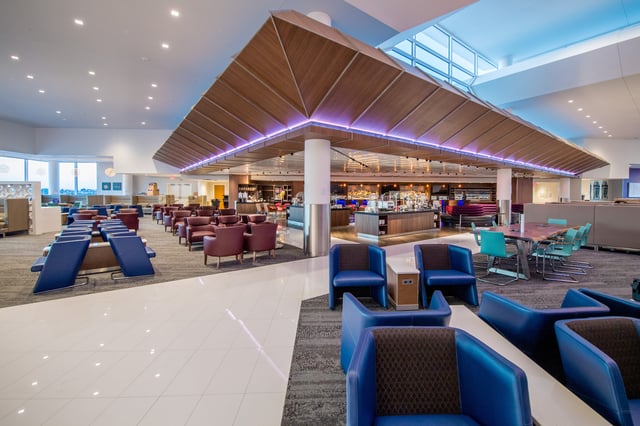
A SkyClub at Hartsfield–Jackson Atlanta International Airport
Delta Sky Club is the branding name of Delta's airport lounges.
Membership is available through an annual membership that can be purchased with either money or miles.
International passengers traveling in Delta One class get free access.
Membership can also be granted through top level Delta status or by being an American Express card holder with certain exceptions.
As of January, 2019, Delta no longer offers single day passes.[104]
Features vary by location, but generally include free drinks (including alcoholic beverages), snacks, and reading material.
Wi-Fi is free for members and guests and is mostly provided in the US by AT&T.
Originally, Delta's membership-based airport clubs were called Crown Room lounges, with Northwest's called WorldClubs.
SkyBonus
On November 27, 2001, Delta Air Lines launched SkyBonus,[104] a program aimed toward small-to-medium businesses spending between $5,000 and $500,000 annually on air travel.[106] Businesses can earn points toward free travel and upgrades, as well as Sky Club memberships and SkyMiles Silver Medallion status. Points are earned on paid travel based on a variety of fare amount paid, booking code, and place origin or destination.[107] While enrolled businesses are able to earn points toward free travel, the travelling passenger is still eligible to earn SkyMiles during his or her travel.[107]
In early 2010, Delta Air Lines merged its SkyBonus program with Northwest's similar Biz Perks program.[107]
Corporate affairs
Headquarters and offices
Delta's corporate headquarters is located on a corporate campus on the northern boundary of Hartsfield-Jackson Atlanta International Airport, within the city limits of Atlanta.[108][109][110] This location has served as Delta's headquarters since 1941, when the company relocated its corporate offices from Monroe, Louisiana to Greater Atlanta.[111][112] The crop dusting division of Delta remained headquartered in Monroe until Delta ceased crop dusting in 1966.[1] Before 1981, the Delta corporate campus, an 80-acre (32 ha) plot of land in proximity to the old Hartsfield Airport terminal, was outside the City of Atlanta limits in unincorporated Fulton County. On August 3, 1981, the Atlanta City Council approved the annexation of 141 acres (57 ha) of land, an area containing the Delta headquarters. As of 1981 Delta would have had to begin paying $200,000 annually to the City of Atlanta in taxes. In September 1981, the airline sued the city, challenging the annexation on the basis of the constitutionality of the 1960 City of Atlanta annexation of the Hartsfield old terminal.[113] The City of Atlanta was only permitted to annex areas that are adjacent to areas already in the Atlanta city limits.[113]
In addition to hosting Delta's corporate headquarters, Hartsfield-Jackson is also the home of Delta TechOps, the airline's primary maintenance, repair, and overhaul arm and the largest full-service airline MRO in North America, specializing in engines, components, airframe, and line maintenance.[114]
Finances
For the fiscal year 2018, Delta Air Lines reported earnings of US$5.1 billion, with an annual revenue of US$44.438 billion, an increase of 8.02% over the previous fiscal cycle.
Its shares traded at over $48 per share, and its market capitalization was valued at over US$39.182 billion in April 2019.[117]
| Year | Revenuein mil.USD$ | Net incomein mil.USD$ | Total Assetsin mil.USD$ | Price per Sharein USD$ | Employees | Refs |
|---|---|---|---|---|---|---|
| 2005 | 16,480 | −3,836 | 20,039 | [118] | ||
| 2006 | 17,532 | −6,205 | 19,622 | [119] | ||
| 2007 | 19,154 | 1,612 | 32,423 | [120] | ||
| 2008 | 22,697 | −8,922 | 45,084 | 8.76 | [121] | |
| 2009 | 28,063 | −1,237 | 43,789 | 6.97 | [122] | |
| 2010 | 31,755 | 593 | 43,188 | 11.66 | [123] | |
| 2011 | 35,115 | 854 | 43,499 | 8.59 | [124] | |
| 2012 | 36,670 | 1,009 | 44,550 | 9.321 | [125] | |
| 2013 | 37,773 | 10,540 | 52,252 | 18.53 | 78,000 | [126] |
| 2014 | 40,362 | 659 | 54,005 | 35.12 | 80,000 | [127] |
| 2015 | 40,704 | 4,526 | 53,134 | 43.42 | 83,000 | [128] |
| 2016 | 39,639 | 4,373 | 51,261 | 41.11 | 84,000 | [129] |
| 2017 | 41,244 | 3,577 | 53,292 | 48.52 | 87,000 | [130] |
| 2018 | 44,438 | 3,935 | 60,270 | 47.83 | 89,000 | [131][132] |
Personnel
Between its mainline operation and subsidiaries, and as of March 2015, Delta employs nearly 80,000 people.[10] Ed Bastian is the current Chief Executive Officer and has served in this position since May 2, 2016.[133] Joanne Smith is Executive Vice President and Chief Human Resources Officer responsible for the oversight and support of personnel needs at Delta. She was appointed on October 1, 2014, replacing Mike Campbell.[134]
Delta's 14,500 mainline pilots are represented by the Air Line Pilots Association, International and are the union's largest pilot group.[135][136] The company's approximately 180 flight dispatchers are represented by the Professional Airline Flight Control Association (PAFCA).[137] Not counting the pilots and flight dispatchers, Delta is the only one of the five largest airlines in the United States, and one of only two in the top 9 (the other being JetBlue), whose non-pilot USA domestic staff is entirely non-union.[135]
Branding
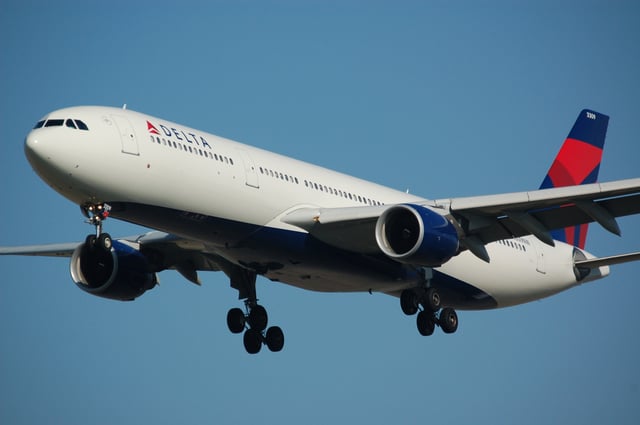
An Airbus A330-300 painted in Delta's current livery, "Upward & Onward"
Delta's current livery is called "Upward & Onward". It features a white fuselage with the company's name in blue lettering, and a widget on the vertical stabilizer. Delta introduced its current livery in 2007 as part of a re-branding after it emerged from bankruptcy. The new livery consists of four colors, while the old one (called "colors in motion") used eight. This meant the switch saved the airline money by removing one day from each aircraft's painting cycle. The airline took four years to repaint all of its aircraft into the current scheme, including aircraft inherited from Northwest Airlines.[138]
Environmental initiatives
In 2008, Delta Air Lines was given an award from the United States Environmental Protection Agency's Design for the Environment (DfE) program for their use of PreKote, a more environmentally friendly, non-hexavalent chromium surface pretreatment on its aircraft, replacing hazardous chemicals formerly used to improve paint adhesion and prevent corrosion. In addition, PreKote reduces water usage by two-thirds and reduces wastewater treatment.
PreKote is also saving money by reducing the time needed to paint each airplane.
With time savings of eight to ten percent, it will save an estimated more than $1 million annually.[140]
In popular culture
Deltalina
As part of the rebranding project, a safety video featuring a flight attendant showed up on YouTube in early 2008, getting over 1 million views and the attention of news outlets, specifically for the video's tone mixed with the serious safety message. The flight attendant, Katherine Lee, was dubbed "Deltalina" by a member of FlyerTalk for her resemblance to Angelina Jolie.[141][142] Delta had considered several styles for its current safety video, including animation, before opting for a video presenting a flight attendant speaking to the audience. The video was filmed on a former Song Airlines Boeing 757-200.[143]
Accidents and incidents
The following are major accidents and incidents that occurred on Delta mainline aircraft.
For Northwest Airlines incidents, see Northwest Airlines accidents and incidents. For Delta Connection incidents, see Delta Connection incidents and accidents.
| Flight | Date | Aircraft | Location | Description | Casualties | ||||
|---|---|---|---|---|---|---|---|---|---|
| Fatal | Serious | Minor | Uninjured | Ground | |||||
| 4[144] | August 14, 1935 | Stinson Model A | Gilmer, Texas | En route toShreveport, Louisiana, the left engine was ripped off of the aircraft due to a propeller blade failure.The pilot attempted to make an emergency landing in a cotton field, but lost control and crashed. | 4 | 0 | 0 | 0 | 0 |
| N/A[145] | April 22, 1947 | Douglas DC-3 | Columbus, Georgia | AVultee BT-13, owned by theTuskegee Aviation Institute, landed on top of a Delta DC-3, which was flying from Macon to Columbus. | 9 (8 on DC-3) | 0 | 0 | 0 | 0 |
| 705[146] | March 10, 1948 | DC-4 | Chicago | Crashed near Chicago Municipal (Midway) Airport shortly after takeoff while en route to Miami.Officials determined that longitudinal control of the airplane was lost resulting in the crash.The cause for the loss of control remains undetermined. | 12 | 1 | 0 | 0 | 0 |
| 318[147] | May 17, 1953 | DC-3 | Marshall, Texas | Crashed 13 miles (21 km) east of Marshall, Texas.The flight, which originated fromDallas Love Field, was on approach toShreveport, Louisiana.The crash was attributed to adverse weather conditions with a thunderstorm in the area. | 19 | 1 | 0 | 0 | 0 |
| 1903 | May 23, 1960 | Convair 880 | Atlanta | Crashed during a training exercise in Atlanta.The aircraft stalled and crashed killing all four crew members. | 4 | 0 | 0 | 0 | 0 |
| 9877[148] | March 30, 1967 | DC-8 | New Orleans | Crashed during a training exercise nearNew Orleans.The improper use of flight and power controls by both instructor and the Captain-trainee during a simulated two-engine out landing approach, resulted in the loss of control.The aircraft crashed into a residential area, destroying several homes and a motel complex and killing 13 people on the ground.[149] | 6 | 0 | 0 | 0 | 13 |
| 9570[150] | May 30, 1972 | McDonnell Douglas DC-9 | Fort Worth, Texas | A training exercise, crashed during landing procedures in Fort Worth, Texas.The probable cause of the accident was wake turbulence resulting from atouch-and-go landingmoments before of American Airlines Flight 1114, operated using aDC-10.The right wing hit the ground causing a fire resulting in the aircraft being written off. | 4 | 0 | 0 | 0 | 0 |
| 954[151] | December 20, 1972 | Convair 880 | Chicago | The Delta CV-880 taxied across runway 27L in heavy fog.At the same time,North Central AirlinesFlight 575, aMcDonnell Douglas DC-9-31, took off from the same runway.The aircraftcollided. | 10 (all onMcDonnell Douglas DC-9-31) | 0 | 17 (severity unknown) | 101 | 0 |
| 723 | July 31, 1973 | McDonnell Douglas DC-9 | Boston | Crashed into a seawall.Contributing to the accident was a defective flight deck instrument giving the crew misleading guidance during the instrument approach in visibility less than a half mile with 500-foot (150 m) cloud ceilings.89 occupants died including Leopold Chouinard, who died from burns months after the accident, leaving no survivors.[152][153] | 89 | 0 | 0 | 0 | 0 |
| 516[154] | November 27, 1973 | McDonnell Douglas DC-9 | Chattanooga | Crashed into approach lights during a thunderstorm.[155] | 0 | 4 | 75 | 0 | 0 |
| 1080 | April 12, 1977 | Lockheed L-1011 Tristar | Los Angeles | Emergency landing at Los Angeles International Airport due to a jammed stabilizer during a flight from San Diego International Airport.The cause of the incident was a lack of greasing due to a high amount of water entering the metal bearings caused by weather factors.All 52 passengers and crew on board survived.[156] | 0 | 0 | 0 | All | 0 |
| 191 | August 2, 1985 | Lockheed L-1011 Tristar | Dallas–Fort Worth | On aFort Lauderdale–Dallas/Fort Worth
| 136 | 13 | 13 | 2 | 1 |
| 37[158] | July 8, 1987 | Lockheed L-1011 | North Atlantic Ocean | Near collision with aContinental Airlines747 carrying 418 passengers and crew.Both the Delta (London-Cincinnati) and Continental (London-Newark) were heading to the U.S. with nearly 600 people total on both aircraft.The Delta flight strayed 60 miles (97 km) off course to the south from its assigned "C" track during its flight and came within 30 feet (9.1 m) of colliding with the 747 as the L-1011 flew under it in Canadian airspace, flying on the "D" track (there are five westbound and five eastbound tracks from the United States to the United Kingdom).Had the planes actually collided, it could have tied theTenerife airport disasteras the deadliest aviation accident in history. | 0 | 0 | 0 | All | 0 |
| 1141 | August 31, 1988 | Boeing 727 | Dallas–Fort Worth | Crashed after takeoff bound for Salt Lake City, Utah.The investigation stated the probable cause of this accident to be improper configuration of the flaps and leading edge slats. | 14 | 26 | 50 | 18 | 0 |
| 1288[159] | July 6, 1996 | MD-88 | Pensacola | An uncontained engine failure of the port (left) engine on the aircraft resulted in a fan hub piercing the cabin.The flight was scheduled to fly to Atlanta.The aircraft involved in this accident, N927DA, was repaired and returned to service.The aircraft was eventually retired on August 10, 2018.[160] | 2 | 2 | 3 | 135 | 0 |
| 1989[161][162] | September 11, 2001 | Boeing 767-300 | En route fromBoston | Flight 1989, bound for Los Angeles International Airport was caught in the path ofUnited Airlines Flight 93.The two aircraft were so close that ATC were initially confused as to which plane had been hijacked.The Delta pilot managed to avoidUnited 93and the flight was later diverted toCleveland Hopkins International Airport.[162] | 0 | 0 | 0 | All | 0 |
| 129[163] | February 3, 2002 | McDonnell Douglas MD-11 | Dublin | Flight 129 from Atlanta skidded off the runway at Dublin Airport in high winds.The port engine of MD-11 N803DE had severe damage.[164] | 0 | 0 | 0 | All | 0 |
| 1086 | March 5, 2015 | McDonnell Douglas MD-88 | LaGuardia Airport | While landing in heavy snowfall, Flight 1086 from Atlanta departed the left side of runway while traveling approximately 100 mph (160 km/h), coming to rest nearly perpendicular to the runway with its nose on an embankment beside the waters ofFlushing Bay.The accident resulted in damage to the aircraft's left wing (including a fuel leak), nose landing gear well, main electronics bay, nose radome/weather radar, and undercarriage damage forward of the front doors.The aircraft's braking system and condition of the runway surface are being considered as possible causes of the incident.[165][166] | 0 | 0 | 23 | 109 | 0 |
| 159 | June 16, 2015 | Boeing 747-400 | Over Chineseairspace | Flight 159 from Detroit Metropolitan Wayne County Airport toSeoul,Incheon International Airportwas over Chinese airspace when the aircraft flew through a severe hailstorm.This resulted in substantial damage to the aircraft's radome (hail penetrating nose causing a large hole) as well as leading edges of the wing destroyed and damage to the tail plane.[167][168]This aircraft was written off due to its age and because Delta had already began retiring its Boeing 747-400 fleet.[169]Temporary repairs were made (to make it air-worthy) and the aircraft was ferried from Seoul toPinal Airparkin Marana, Arizona. | 0 | 0 | 0 | All | 0 |
The attempted bombing of Northwest Airlines Flight 253 on December 25, 2009, occurred four days before the operating certificates of Northwest and Delta were combined (December 31, 2009). The aircraft involved in the incident was in Delta livery and reported in some early news reports as "Delta Flight 253."[170]
Hijackings
There have been over a dozen attempted hijackings that resulted in no injuries and the surrender of the often lone hijacker.
These incidents are not included.
The following are notable hijackings because of fatalities or success in forcing the aircraft to fly to another country:
On February 21, 1968, a Delta DC-8 was hijacked to Havana, Cuba.
This was the first successful hijacking to Cuba from the U.S. since 1961, and was the start of multiple hijacking attempts to Cuba in the late 1960s.
This coincided with the introduction of passenger screening using metal detectors in U.S. airports starting in the late 1960s.
On July 31, 1972, Delta Flight 841, a Detroit to Miami DC-8 flight, was hijacked to Algiers, Algeria by 8 hijackers. The aircraft stopped in Boston to pick up an international navigator. The flight was allowed to return with passengers to the U.S., stopping in Barcelona for refueling.[171][172]
On February 22, 1974, Samuel Byck, an unemployed tire salesman from Pennsylvania, shot and killed an Aviation Police Officer, then stormed aboard Delta Air Lines Flight 523, a McDonnell Douglas DC-9 flight at Baltimore Friendship Airport (now Baltimore–Washington International Airport) scheduled to fly to Atlanta, and shot both pilots, killing the First Officer, Fred Jones. He intended to crash the plane into the White House.[173] After shooting the pilots, the hijacker grabbed a passenger and demanded that she fly the aircraft.[174] The passengers meanwhile fled the aircraft. The hijacking attempt ended when, after a standoff with police, Byck was shot twice through an aircraft porthole by a Maryland policeman, severely wounding him. Before police stormed the plane, Byck killed himself. The plane never left the gate during this incident.
On August 23, 1980, a Delta Air Lines L-1011 on a San Juan to Los Angeles flight was hijacked and flown to Cuba.[175] The hijacker was jailed by Cuban authorities, and all passengers were released unharmed.
On September 13, 1980, a Delta Air Lines New Orleans to Atlanta flight was taken over by two hijackers and forced to fly to Cuba.
The flight continued to Atlanta after stopping in Havana.
The hijackers were imprisoned by Cuban authorities.
One hijacker was released and later sought US residency.
The suspect was later arrested by US authorities in 2002[176] and sentenced to 10 years in prison the following year.[177]
Additional hijackings that resulted in no injuries and the flight landing in Cuba include March 28, 1984 (Delta 357, a 727, New Orleans-Dallas),[178] August 18, 1983 (Delta 784, a 727, Miami-Tampa),[179] July 17, 1983 (Delta 722, a 727, Miami-Tampa),[180] and June 11, 1979 (Delta 1061, a L-1011, New York LaGuardia-Fort Lauderdale).[181]
See also
Air transportation in the United States
Delta Flight Museum
Delta Global Staffing
List of airlines of the United States
List of airports in the United States
Transportation in the United States
Delta Ship 41
